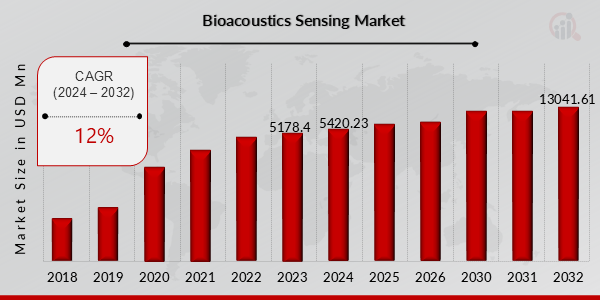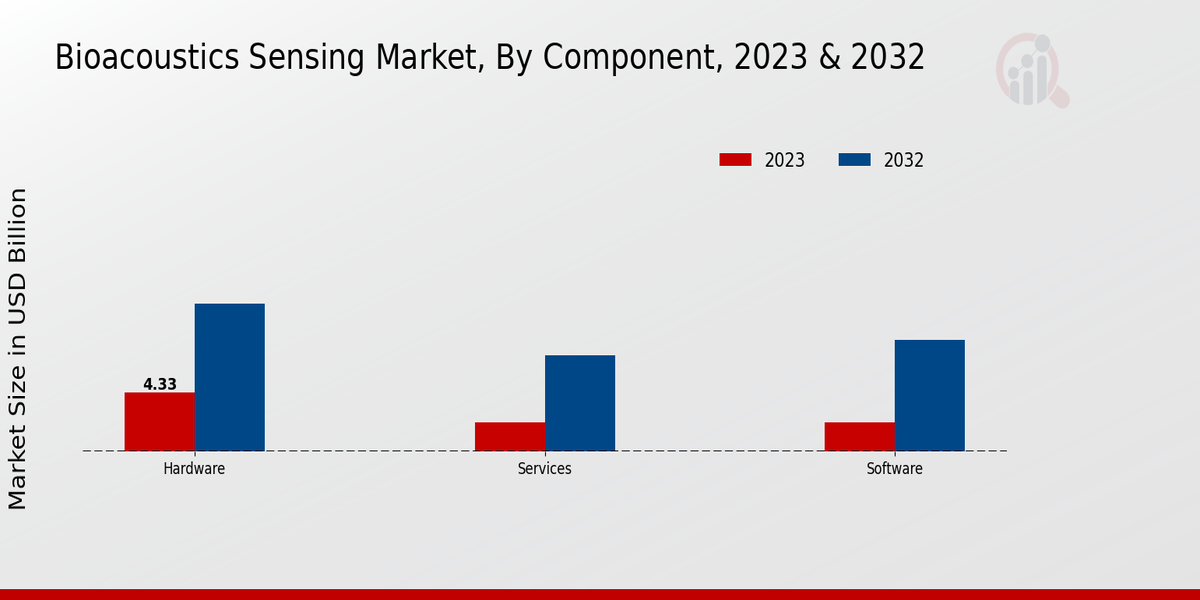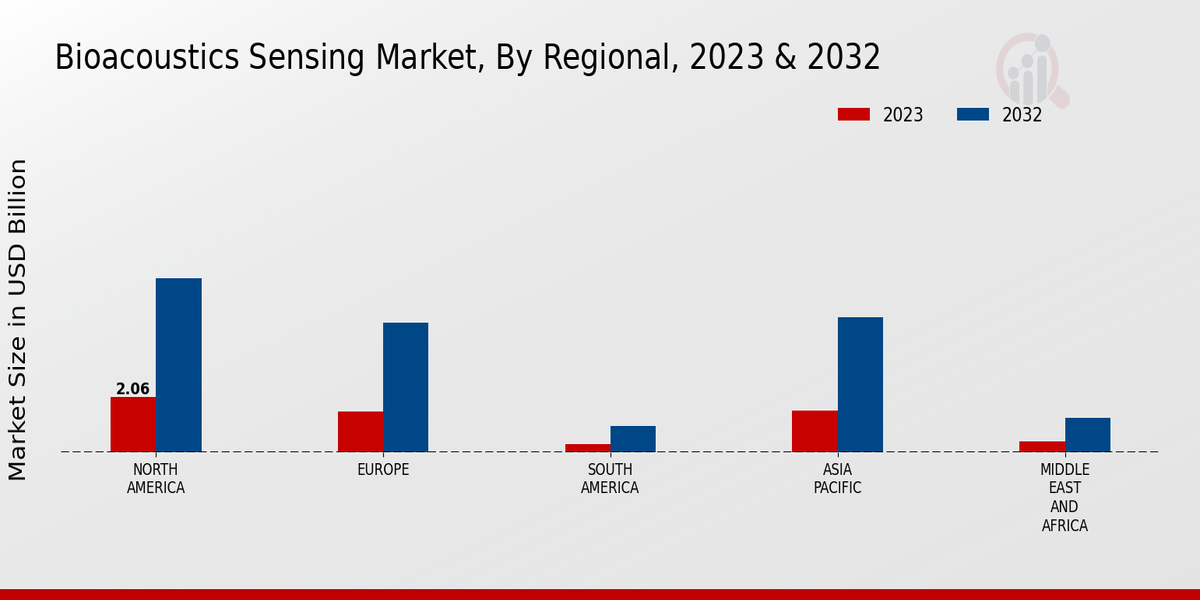Global Bio-Acoustics Sensing Market Overview:
The Bio-Acoustics Sensing Market Size was estimated at 5178.4 (USD Million) in 2023. The Bio-Acoustics Sensing Market Industry is expected to grow from 5420.23 (USD Million) in 2024 to 13041.61 (USD Million) by 2032. The Bio-Acoustics Sensing Market CAGR (growth rate) is expected to be around 12% during the forecast period (2024 - 2032).
Key Bio-Acoustics Sensing Market Trends Highlighted
In the realm of bioacoustics sensing, advancements in technology and heightened awareness of environmental conservation are driving the market's growth. The ability to monitor biodiversity, track animal migrations, and detect marine mammals for research and conservation purposes has spurred demand.
Recent trends in the Bio-Acoustics Sensing Market demonstrate the growing emphasis on data analytics and visualization. Leveraging artificial intelligence and machine learning, researchers are unlocking insights from complex acoustic data, improving species identification accuracy and uncovering patterns in animal behavior.
Opportunities to be explored include the integration of bioacoustics sensing with other technologies, such as remote sensing and environmental monitoring systems. This convergence enhances data collection and provides a comprehensive understanding of ecosystems. Additionally, developing cost-effective and miniaturized sensors holds the potential for broader adoption and deployment in remote and challenging environments.

Source: Primary Research, Secondary Research, MRFR Database and Analyst Review
Bio-Acoustics Sensing Market Drivers
Rising Demand for Bioacoustics Sensing in Environmental Monitoring
The growing concern over environmental pollution and the need for effective monitoring solutions are driving the demand for bioacoustics sensing in the Global Bio-Acoustics Sensing Market Industry. Bioacoustics sensing offers a non-invasive and cost-effective method to monitor wildlife populations, detect invasive species, and assess the impact of human activities on ecosystems. By analyzing the sounds produced by animals, researchers and conservationists can gain valuable insights into species distribution, abundance, and behavior. As environmental regulations become more stringent and the need for sustainable practices increases, the adoption of bioacoustics sensing is expected to accelerate significantly.
Advancements in Acoustic Sensing Technology
Technological advancements in acoustic sensing are creating new opportunities for the Global Bio-Acoustics Sensing Market Industry. The development of miniaturized and low-power sensors, along with improvements in signal processing and machine learning algorithms, is enhancing the accuracy, reliability, and affordability of bioacoustics sensing systems. These advancements enable the deployment of dense sensor networks for continuous monitoring, providing real-time data and early warning systems for environmental protection and wildlife conservation.
Integration with Data Analytics and Artificial Intelligence
The integration of bioacoustics sensing with data analytics and artificial intelligence (AI) is unlocking new possibilities for the Global Bio-Acoustics Sensing Market Industry. AI algorithms can analyze vast amounts of acoustic data to identify patterns, classify species, and detect anomalies. This enables researchers to gain deeper insights into animal behavior, population dynamics, and the impact of environmental changes. By combining bioacoustics sensing with advanced data analytics, scientists can develop predictive models and improve decision-making for conservation and management strategies.
Bio-Acoustics Sensing Market Segment Insights:
Bio-Acoustics Sensing Market Component Insights
The Global Bio-Acoustics Sensing Market is segmented into hardware, software, and services. The hardware segment is expected to hold the largest market share of 41.9% by 2026, owing to the increasing demand for bioacoustic sensors and devices for various applications. The software segment is anticipated to witness the highest growth rate of 14.8% during the forecast period due to the growing adoption of advanced software solutions for bioacoustics sensing and analysis. The services segment is expected to account for a significant market share, driven by the rising demand for professional services such as system integration, data analysis, and consulting.

Source: Primary Research, Secondary Research, MRFR Database and Analyst Review
Bio-Acoustics Sensing Market Application Insights
The application segment of the Global Bio-Acoustics Sensing Market holds significant growth potential, driven by increasing demand for real-time monitoring and data collection in various domains. Conservation and Monitoring is a crucial application, accounting for a considerable share of the market revenue in 2023. This segment focuses on utilizing bioacoustics to track and protect endangered species, monitor biodiversity, and assess the impact of human activities on ecosystems. Acoustic Habitat Mapping is another key application, enabling the characterization of underwater environments and providing insights into the distribution and behavior of marine life.
Species Classification and Identification leverage bioacoustics to identify and classify species based on their unique vocal patterns, contributing to research and conservation efforts. Population Assessment utilizes bioacoustics to estimate population sizes and monitor population trends, informing management strategies for wildlife conservation. Remote Sensing applications employ bioacoustics to collect data from remote locations, facilitating the monitoring of vast areas and inaccessible habitats.
Bio-Acoustics Sensing Market Technology Insights
The Global Bio-Acoustics Sensing Market is expected to grow significantly in the coming years, driven by increasing demand for environmental monitoring, wildlife conservation, and security applications. The market is segmented into various technologies, including passive acoustic monitoring, active acoustic sensing, and remote sensing. Among these, passive acoustic monitoring is expected to hold the largest market share in 2024 due to its cost-effectiveness and ease of deployment.
Active acoustic sensing is expected to grow at a faster rate during the forecast period, owing to its ability to provide real-time data and its use in applications such as underwater target detection and classification.Remote sensing is expected to gain traction in the coming years due to its ability to monitor large areas remotely and its use in applications such as habitat mapping and wildlife tracking.
Bio-Acoustics Sensing Market Deployment Type Insights
Deployment Type Segment Insights and Overview The deployment type segment of the Global Bio-Acoustics Sensing Market can be classified into fixed and mobile. The fixed deployment type involves the installation of bioacoustic sensors in a specific location, such as a marine environment or a protected area. This type of deployment is typically used for long-term monitoring and data collection. On the other hand, the mobile deployment type involves the use of portable or wearable bioacoustic sensors that can be moved from one location to another.
This type of deployment is suitable for short-term monitoring or for applications where flexibility and mobility are essential.In 2023, the fixed deployment type accounted for a larger share of the Global Bio-Acoustics Sensing Market revenue due to its wide adoption in long-term monitoring projects. However, the mobile deployment type is expected to witness significant growth in the coming years, driven by the increasing demand for portable and wearable bioacoustic sensors for applications such as wildlife tracking and environmental monitoring. This growth is expected to be supported by advancements in sensor technology, miniaturization, and wireless communication capabilities.
Bio-Acoustics Sensing Market End User Insights
The Global Bio-Acoustics Sensing Market is segmented by End User into Researchers and Scientists, Environmental Consultants, Government Agencies, and Conservation Organizations. Among these segments, Researchers and Scientists held the largest market share in 2023, accounting for around 38.5% of the Global Bio-Acoustics Sensing Market revenue. This dominance can be attributed to the increasing adoption of bioacoustics sensing technologies by researchers and scientists for wildlife monitoring, biodiversity assessment, and habitat characterization.
Environmental Consultants are expected to witness the fastest market growth during the forecast period, with a CAGR of 14.2% from 2024 to 2032.This growth can be attributed to the rising demand for environmental impact assessments and the need for monitoring and mitigating the impact of human activities on wildlife and ecosystems. Government Agencies and Conservation Organizations also represent significant segments of the Global Bio-Acoustics Sensing Market, contributing to the overall market growth and demand for bioacoustics sensing technologies for conservation and management efforts.
Bio-Acoustics Sensing Market Regional Insights
The regional segmentation of the Global Bio-Acoustics Sensing Market offers valuable insights into the geographical distribution of market growth and opportunities. North America is anticipated to dominate the market with a significant share due to the presence of leading industry players, advanced healthcare infrastructure, and increasing research and development activities. Europe holds the second-largest market share, driven by government initiatives, favorable reimbursement policies, and a growing senior population.
The Asia-Pacific (APAC) region is projected to witness the fastest growth rate owing to rising healthcare expenditure, increasing awareness about bioacoustics sensing technologies, and government support for healthcare innovation.South America and the Middle East and Africa (MEA) regions are expected to contribute a notable share to the overall market, with a growing demand for affordable and accessible healthcare solutions.

Source: Primary Research, Secondary Research, MRFR Database and Analyst Review
Bio-Acoustics Sensing Market Key Players And Competitive Insights:
Major players in the Bio-Acoustics Sensing Market are investing heavily in research and development to enhance their product offerings and gain a competitive edge. They are also focusing on strategic partnerships, acquisitions, and collaborations to expand their market reach and strengthen their position in the industry. Leading Bio-Acoustics Sensing Market players are continuously innovating and introducing new products with advanced features and capabilities to cater to the evolving needs of customers. The Bio-Acoustics Sensing Market development is driven by factors such as increasing environmental concerns, growing demand for non-invasive monitoring techniques, and advancements in sensor technology.
The competitive landscape of the Bio-Acoustics Sensing Market is expected to remain dynamic, with key players vying for market share through product differentiation, strategic alliances, and aggressive marketing campaigns.Among the leading players in the Global Bio-Acoustics Sensing Market, Wildlife Acoustics is a prominent company renowned for its expertise in developing and manufacturing high-quality acoustic monitoring devices for ecological research and conservation applications. The company's products include acoustic recorders, microphones, and software solutions for data analysis and interpretation. Wildlife Acoustics has a strong global presence and caters to a diverse customer base, including researchers, wildlife managers, and conservation organizations.
The company's commitment to innovation and customer satisfaction has earned it a reputation for excellence within the industry.Another key competitor in the Global Bio-Acoustics Sensing Market is Applied Bioacoustics, a leading provider of acoustic monitoring solutions for various applications, including wildlife research, habitat assessment, and pest management. The company's product portfolio encompasses acoustic recorders, software for data analysis, and consulting services. Applied Bioacoustics is known for its innovative technologies and its ability to customize solutions to meet specific customer requirements. The company has a strong presence in the North American market and is also expanding its reach into international markets.
Key Companies in the Bio-Acoustics Sensing Market Include:
Bio-Acoustics Sensing Industry Developments
The Global Bio-Acoustics Sensing Market is anticipated to grow significantly over the forecast period. Increasing adoption of bioacoustics sensing technologies in various applications, such as environmental monitoring, wildlife conservation, and medical diagnostics, is driving the market growth. Government initiatives and regulations aimed at protecting biodiversity and promoting sustainable practices further contribute to the market's expansion. Advancements in sensor technology, data analytics, and artificial intelligence are also creating new opportunities for market growth. Key market players are focusing on developing innovative solutions to meet the evolving needs of customers, leading to a competitive and dynamic market landscape.
Bio-Acoustics Sensing Market Segmentation Insights
Bio-Acoustics Sensing Market Component Outlook
Bio-Acoustics Sensing Market Application Outlook
- Conservation and Monitoring
- Species Classification and Identification
Bio-Acoustics Sensing Market Technology Outlook
- Passive Acoustic Monitoring
Bio-Acoustics Sensing Market Deployment Type Outlook
Bio-Acoustics Sensing Market End User Outlook
- Researchers and Scientists
- Environmental Consultants
- Conservation Organizations
Bio-Acoustics Sensing Market Regional Outlook
| Report Attribute/Metric |
Details |
| Market Size 2023 |
5178.4 (USD Million) |
| Market Size 2024 |
5420.23 (USD Million) |
| Market Size 2032 |
13041.61 (USD Million) |
| Compound Annual Growth Rate (CAGR) |
12% (2024 - 2032) |
| Report Coverage |
Revenue Forecast, Competitive Landscape, Growth Factors, and Trends |
| Base Year |
2023 |
| Market Forecast Period |
2024 - 2032 |
| Historical Data |
2019 - 2022 |
| Market Forecast Units |
USD Million |
| Key Companies Profiled |
World Wildlife Fund, Environmental Defense Fund, The Nature Conservancy, BirdLife International, National Audubon Society, Biosphere Soundscapes, Merlin Tuttle's Bat Conservation, NatureServe, International Union for Conservation of Nature, Sound Metrics Corporation, Conservation International, The Cornell Lab of Ornithology, Wildlife Acoustics, Bat Conservation Trust |
| Segments Covered |
Component, Application, Technology, Deployment Type, End User, Regional |
| Key Market Opportunities |
Precision Agriculture, Environmental Monitoring, Wildlife Conservation, Biodiversity Research, Bioacoustics Surveillance |
| Key Market Dynamics |
Growing environmental concerns Advancements in technology Rising adoption in wildlife monitoring Expansion of the healthcare industry Increasing government support |
| Countries Covered |
North America, Europe, APAC, South America, MEA |
Frequently Asked Questions (FAQ):
The Global Bio-Acoustics Sensing Market is expected to be valued at approximately USD 5178.4 Million in 2023.
The Global Bio-Acoustics Sensing Market is projected to register a CAGR of 12% from 2024 to 2032.
The Global Bio-Acoustics Sensing Market is expected to reach approximately USD 13041.61 Million by 2032.
Some of the key competitors in the Global Bio-Acoustics Sensing Market include Wildlife Acoustics, Inc., Bat Conservation International, and Nortek, Inc.
Key growth drivers of the Global Bio-Acoustics Sensing Market include increasing awareness of the importance of environmental monitoring, technological advancements, and growing demand for non-invasive monitoring techniques.
Major challenges faced by the Global Bio-Acoustics Sensing Market include high costs associated with bioacoustic sensors and limited availability of skilled professionals.
Key trends emerging in the Global Bio-Acoustics Sensing Market include the development of miniaturized sensors and the integration of artificial intelligence (AI) in bioacoustic data analysis.
Potential opportunities for growth in the Global Bio-Acoustics Sensing Market include the expansion of the market in developing countries and the growing demand for bioacoustics sensing in various industries.

















